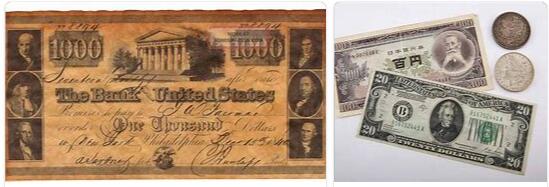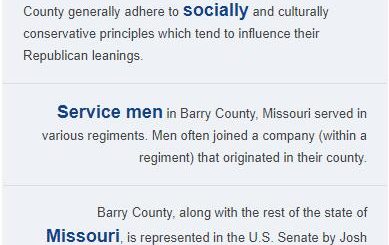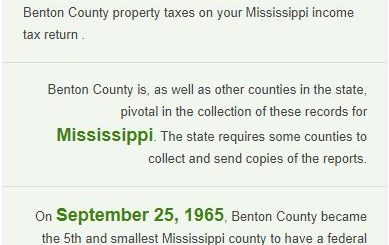United States Money and Banks
“The dollar consists of a gold weight of 25.8 grains (1.6718 grams) at 900 fine”. This is how the North American monetary unit defines the law of March 14, 1900, which closed the debate that began with the creation of the dollar (1792) between the supporters of bimetallism and those of gold monometallism. The same law states that all kinds of coins issued or minted by the United States must be kept at par with the gold dollar thus defined.
As already mentioned, following the banking crisis of March 1933 the gold standard was suspended and 31 January 1934 the gold content of the dollar has been reduced to 15 and 5 / 21grains and its value respectively at 59.06% of the initial value. Withdrawal of the gold coins from circulation, this currently consists of fiduciary coins of various types, issued by the Treasury (gold certificates, silver dollars, silver certificates, 1890 treasury notes, United States notes), by federal banks reserve and national banks, and regulated by special laws, but all benefiting directly or indirectly from the government guarantee and equally legal tender. The convertibility of these currencies into gold has not yet been re-established; however, it is possible to buy or sell gold at the treasury at a fixed price of 36 dollars per ounce.
Gold certificates, whose gold counterpart issue was unlimited, are in the process of being withdrawn due to the new monetary legislation. The silver dollars (weighing 26.7296 grams at 900 fine), created as a monetary unit together with the gold dollar (2 April 1792) and left to subsist, after various events, by the law of 14 March 1900 as a fiduciary currency unlimited liberating power, unless expressly stipulated to the contrary, are now increasing.
Among the other forms of money, as shown in the following table, the notes of the federal reserve are of particular importance, the issue of which – set by the Federal Reserve Act of 1913 as a function of the gold reserve of the federal banks, as well as the quantities of appreciated commercial paper presented at deferral by affiliated banks or purchased on the acceptance market – is the only one capable of adapting to changes in economic activity. The tickets are issued by the Federal Reserve Board at the request of the federal banks, which, by the law of 1913, had to cover their circulation with a gold reserve of at least 40% and with a reserve of primary commercial paper for the remaining 60%. The Glass Steagall bill of February 27, 1932, he authorized the use as a reserve of US government bonds, thus removing the character of pure banknotes from the banknotes in order to bring them closer to paper money. Federal Reserve Notes, as well as Federal Reserve Bank Notes, enjoy a first-degree privilege over all assets of the issuing banks.
The F. R. A. 1913 left the issuing power of the national banks regulated by the National Bank Act of February 3, 1844. The issuance of these notes, guaranteed by the deposit with the treasury of a corresponding amount of government legal currency equal to 5% of the circulation of the individual banks, cannot exceed the fully paid-up capital of the banks themselves.
The banking system before the Federal Reserve Act December 23, 1913, was essentially made up of national banks governed by federal law and having the de facto privilege of issuing, and banks subject to the particular legislation of the states. To the complexity and lack of unity of this system, while always taking into account the different situations of savings and credit in the various areas of the American territory, the 1913 law, intended to coordinate the country’s banking policy, wanted to put an end. establishment of a central regulatory body. The country was divided into 12 districts (Boston, New York, Philadelphia, Cleveland, Richmond, Atlanta, Chicago, Saint Louis, Minneapolis, Kansas City, Dallas, San Francisco), each with a federal reserve bank (with capital not less than to $ 4 million), and,
National banks and state banks were theoretically left free to join the FRS or not, but practically enormous pressure was exerted on the former, which all became members of the system, while the latter, fearful of not being able to resist the power of the banks and to the stricter rules of the federal system, they largely abstained. Great facilitations were then adopted in their favor in 1917 with the result of increasing the number of state-affiliated banks from 250 (1917) to 1639 (1922), a number which, following resignations, mergers or extinctions, was then progressively reduced. As of March 4, 1936, out of 15,808 American banks, 6377 were members of the FRS (5375 national banks and 1002 state banks) and 9431 (almost exclusively commercial and savings banks) were out of it. The member banks, despite their numerical inferiority, nevertheless held almost ⅔ of the total amount of deposits on the same date.
To guarantee their operations, the member banks are required to deposit with the Federal Reserve Bank, on which they depend, a percentage of their passive deposits which from a minimum of 3% for time deposits rises for sight deposits. (demand deposits) at different heights depending on the greater or lesser prevalence of the speculative element in the credit characteristics of the various districts (13% for banks in the districts of Chicago, New York and St Louis, called Central reserve city banks, 10% for the banks of 60 other important cities, Reserve city banks, and 7% for all the other Country banks). Federal banks (in turn obliged to maintain gold reserves equal to 40% of their circulation and 35% of their deposits) are placed in a position to control in normal times, through the trend of deposits and through the weekly reports of the member banks, the credit development of all the affiliated banks, and, through both rediscounting and open market operations (buying and selling government bonds on the free market), facilitate the banks themselves to readjust temporary imbalances between deposits and loans.
This organization, as has already been said, has allowed an enormous expansion of credit and, just as it has failed to automatically curb inflation, so it has, on the other hand, put up a great deal of resistance to deflation. The new banking legislation starting from 1933 therefore provided: 1. to extend the FRS to include the state banks and to fix the minimum capital of the banks, in order to eliminate the most fragile elements of the system; 2. to strengthen the power of control and direction of the FR Board in order to ensure a healthy counterpart to deposits and above all to prevent a character through subsidiaries holding company, the member bank engage in stock market speculation; 3. to guarantee bank deposits, through the establishment of the Federal Deposit Insurance Corporation, intended to liquidate banks that closed voluntarily or by order of the currency controller, and to implement a new insurance system among all participating banks.



